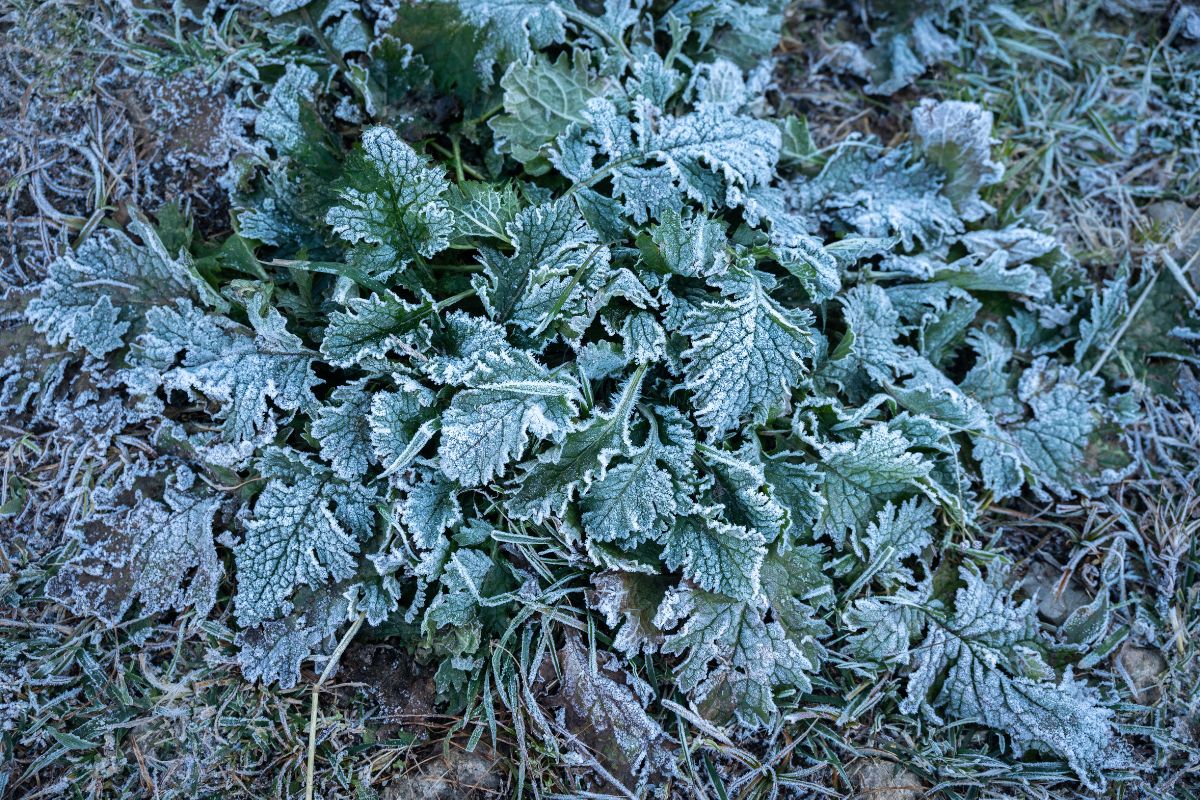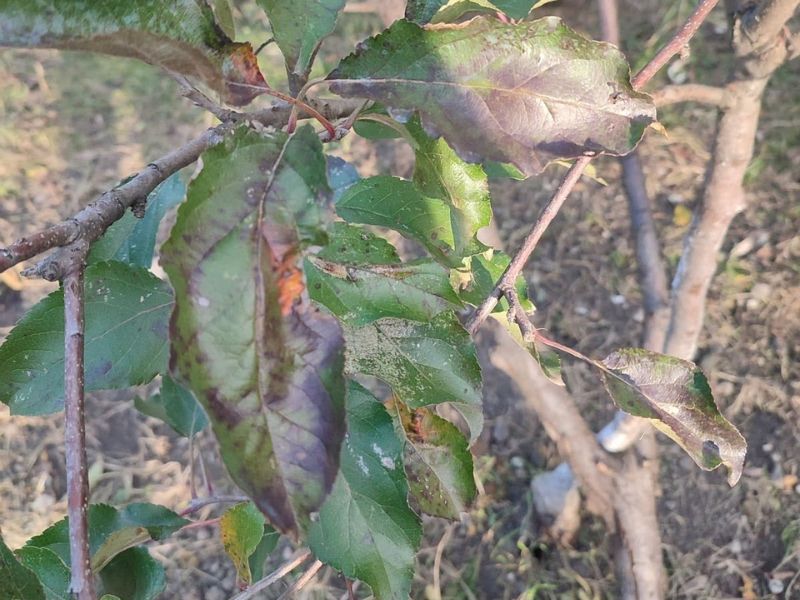
Discolored, brittle spots on new shoots, soggy, translucent leaves, blackened buds — these are common signs of frost damage on plants and require a different response than you’d give to pests and diseases.
With frost damage, patience matters most. You need to wait for new growth before taking action. We’ll walk you through what to look for, with expert advice and images, so you can identify frost damage, assess its severity, and know when to step in, when to hold back, and when to call for landscaping help.
Signs of Frost-Damaged Plants
Discolored Leaves and Stems

Frost-bitten areas on leaves appear whitish and bleached, or turn dark brown to black. The damage can be total or partial — sometimes affecting entire leaves, sometimes just sections, says Shital Poudyal, assistant professor and ornamental horticulture specialist at Utah State University.
Leaf tips and edges, the most exposed areas, dry out and become brittle, causing leaves to curl inward. Frost-damaged stems darken and thin as they dry, often showing visible cracks.
Water-Soaked, Translucent Foliage
Plant leaves turning dark green and soggy? This appearance is more common on tender plants, such as garden annuals, says Emily Merewitz-Holm, an associate professor at Michigan State University and an expert in plant physiology and stress responses.
The water-soaked, wilted look signals internal damage. Ice crystals form inside cells during nights with low temperatures, rupturing cell walls and causing water and cell components to leak out, Merewitz-Holm explains. The damage is irreversible, and “frost-affected plant parts will die,” she adds.
But the entire plant won’t necessarily perish. As long as the stems remain green, there is a good chance of recovery as temperatures warm.
Wilting and Drooping Leaves
When plant parts freeze from the inside, they lose structure and can no longer remain firm and upright.
Damaged leaves and stems go limp, resembling drought stress, though a lack of water in the soil isn’t the culprit. It’s the broken cells inside that can no longer keep their shape.
Leaf Drop
Plants know how to cut their losses. When leaves are too damaged to save, they pull nutrients back into stems and branches and drop what’s beyond repair. This explains the sudden litter of fallen leaves you’ll see beneath frost-damaged plants.
On trees and shrubs that drop their leaves in the fall, frost can sometimes have the opposite effect. If frost hits during mid-cycle, it can disrupt the shedding process. Instead of an accelerated leaf drop, you might notice dry leaves hanging on until late winter or even spring.
Don’t worry; they’ll fall in the spring to make room for new growth.
| Pro Tip: Leaf retention over winter may be a sign of drought stress or root damage. Keep an eye on your tree throughout the season, or, if it’s a valuable one, call an arborist to inspect it. |
Vertical Cracks on Tree Bark
A mix of warm days and frosty nights can damage tree bark. Young trees with thin bark (maples, elms, and fruit trees) are the most vulnerable.
The injury often remains hidden until spring, when resumed growth puts pressure on the damaged layer.
At first, the bark appears sunken and discolored, then it cracks and splits. As it peels away, deep vertical splits become visible on the trunk and sometimes on the branches.
The wound heals naturally over time (it takes a few seasons), but requires protection to prevent the split from extending. Next fall, cover the trunk with white tree wrap before the first frost. The white material reflects sunlight, limiting temperature swings.
See Related: How to Protect Trees From a Freeze
Buds and New Growth Injury
New tender growth and flower buds are usually affected first, says Trista Imrich, a conservation landscape designer and the owner of Southern Branch Nursery in Chesapeake, Virginia. Their soft, water-rich tissue is vulnerable to even brief cold snaps.
Damage is easy to spot — frozen tissue turns a blackish brown on buds, petals, leaves, and young stems. This is the particular cruelty of spring frosts, which hit hardest on the buds and flowers of fruit crops that blossom early, like strawberries, and ornamentals flowering in the spring, such as pansies, primroses, and azaleas.
Affected plants show browned, withered flowers, deformed leaves, and stunted growth. Fruit-bearing plants often produce less fruit that season.
Weather Conditions to Watch For
Damaging frost events typically strike during late fall or spring and are brief, usually lasting for a few hours, says Poudyal.
Calm nights with clear skies and air temperatures between 33 F and 36 F are most prone to frost. These conditions allow temperatures at the plant level to drop to 32 F or below, cold enough for moisture to freeze into ice crystals on leaves and stems.
The effects don’t always show immediately. You may notice changes within hours of the frost melting, but full signs of frost damage often take a couple of days to a week to appear.
Freeze causes similar damage to frost, but is more severe. Freezes occur when temperatures drop between 28 F and 32 F and last longer than frosts. This leads to a higher risk of killing tender plants and causing damage on hardier varieties like ornamental cabbage that typically withstand frost.
| Pro Tip: You can protect plants from a freeze by covering them with landscaping fabric. |
Frost Damage and Type of Plant

Not all plants face frost equally. Perennials and cold-hardy annuals, such as chrysanthemums and marigolds, weather light frost fine, Merewitz-Holm explains. Tender annuals like petunias and zinnias? They’re less hardy and suffer more damage.
Plants face a higher risk of frost damage when temperatures suddenly plunge from warm days to freezing nights, or when a warm spell triggers premature growth.
Even native species, better equipped to handle seasonal fluctuations, can be caught off guard, says Imrich, a native plants advocate — “especially as unusual temperature swings become more frequent with climate change.”
Frost Damage vs. Pests and Diseases
How do you know if it’s frost damage and not something else? According to Poudyal, timing and pattern tell the story. If damage appears after a cold snap, that’s your biggest clue that frost or freeze is the culprit.
Here are a few more signs that can help distinguish frost damage from other types of plant problems.
| Frost Damage | Pest Damage | Disease Damage |
| Appears as uniform damaged areas on leaves, buds, petals, and stems | Usually presents as holes, chew marks, and bites | Often includes spots, wilting, lesions, and cankers |
| It seems to appear suddenly | Insects may be seen on or near the plant or in the soil | May have an orange, yellow, or purple hue |
| Damage develops gradually |
If you’re unsure whether it’s frost damage, a pest, or fungus, call a landscaping pro to check your plants.
Don’t Rush the Treatment
Don’t rush into pruning, says Imrich. Pruning immediately after frost “can stimulate new growth that’s more susceptible to additional cold injury.”
Wait until new growth appears. It will tell you exactly how damaged the plant is and whether you should prune or replace it.
The same rule applies to fertilization. “I don’t recommend fertilizing immediately after frost damage, especially in fall or winter,” Imrich says. “Fertilizer — even organic forms — can encourage new, tender growth that’s more vulnerable to future freezes.”
See Related:
FAQ
Frost damage causes discolored, brittle areas on leaves, buds, flowers, and stems. When temperatures drop lower and persist longer, freeze damage occurs. Ice crystals form inside plant cells, rupturing them and causing more severe injury, especially on tender plants.
Plants start to freeze when temperatures drop to 32 F or below, though the damage they suffer depends on their hardiness.
When to Call a Landscaping Pro
Frost damage can be challenging to evaluate, especially on woody plants. Skip the guessing and hire one of LawnStarter’s landscaping pros to prepare your yard for the new season. They’re the best in their field and can assess the damage, prune your plants correctly, and recommend hardier replacements.
Sources:
Emily Merewitz-Holm, associate professor at Michigan State University, East Lansing, Michigan. Personal interview.
“Frost Cracks in Trees.” By Robert Bricault, Extension horticulture educator. University of Michigan.
“Frost Protection: Fundamentals, Practice, and Economics. Volume I” By Richard L Snyder, biometeorology specialist at the Center for Watershed Sciences – UC Davis, J. Paulo de Melo-Abreu, associate professor at the Technical University of Lisbon. Food and Agriculture Organization of the United Nations.
“Recognizing and Caring for Frost-Damaged Plants.” University of California.
Shital Poudyal, assistant professor at Utah State University, Logan, Utah. Personal interview.
Trista Imrich, a certified horticulturist and the owner of Southern Branch Nursery in Chesapeake, Virginia. Personal interview.
“What’s Up With Trees That Haven’t Lost Their Leaves Yet?” By Brian Wahl, DNR urban forestry coordinator, Fitchburg. Wisconsin Department of Natural Resources.
Main Image: Frost-covered leaves show discoloration and dark spots, indicating the plant has been damaged by freezing temperatures. Photo Credit: boyloso / Adobe Stock